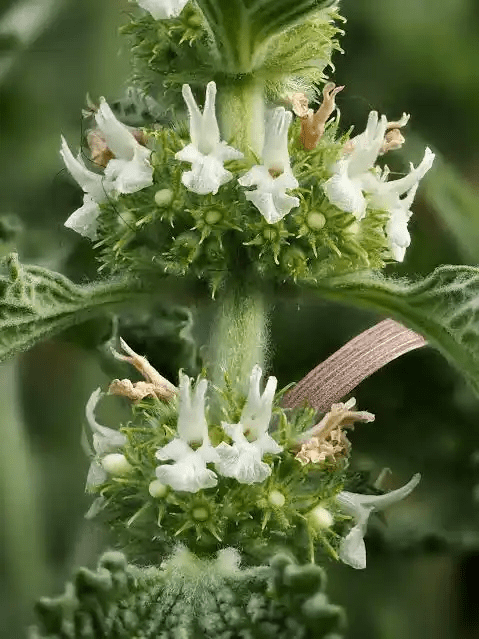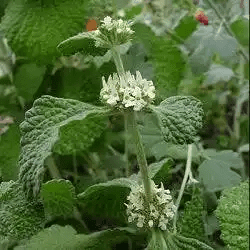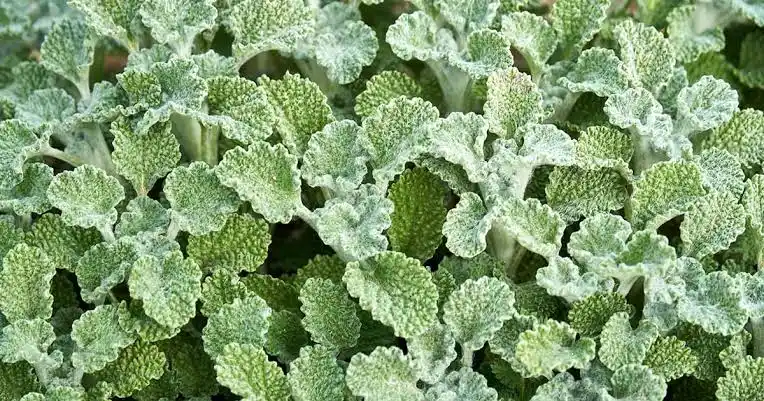Black horehound, scientifically known as Ballota nigra, is a perennial herb that belongs to the Lamiaceae family. Native to Europe and Western Asia, black horehound is characterized by its square stems, opposite leaves, and clusters of small, purplish flowers.
This herb has a long history of use in traditional medicine and has been valued for its potential medicinal properties.
In traditional herbalism, black horehound has been used for various purposes, including its association with digestive health. It has been employed to address issues such as indigestion, bloating, and gas.
The herb is believed to have mild sedative properties and has been historically used to ease nervous tension and promote relaxation.
One of the primary active components in black horehound is marrubiin, a compound that is found in various plants within the Lamiaceae family. Marrubiin is thought to contribute to the herb’s potential effects on the respiratory system. Black horehound has been used traditionally to address coughs, bronchitis, and other respiratory conditions.
Additionally, black horehound has been recognized for its anti-inflammatory properties. Some traditional uses include applying black horehound topically to alleviate skin irritations and minor wounds.
The anti-inflammatory effects are attributed to the presence of compounds such as flavonoids and terpenoids in the herb.
While black horehound has a history of traditional use, it’s important to approach its use with caution. The herb may contain certain compounds that could be toxic in high concentrations.
As with any herbal remedy, it is advisable to consult with healthcare professionals before incorporating black horehound into one’s health regimen, especially for individuals with pre-existing medical conditions or those taking medications.
In contemporary herbalism, black horehound is sometimes included in herbal formulations and supplements designed to support digestive health, ease mild respiratory discomfort, or promote relaxation.
However, research on the specific mechanisms and efficacy of black horehound is limited, and more scientific studies are needed to fully understand its potential benefits and risks.
Ballota nigra, or black horehound, is an herb with a history deeply rooted in traditional medicine. Its traditional uses for digestive and respiratory health, as well as its potential anti-inflammatory properties, make it a subject of interest in the realm of herbal remedies.
As with any herbal remedy, it’s crucial to approach black horehound with caution and seek guidance from healthcare professionals for safe and informed use.
The Botanical Description of Black Horehound
1. Overview: Black Horehound, scientifically known as Ballota nigra, is a perennial herbaceous plant that belongs to the mint family, Lamiaceae. This herbaceous plant is characterized by its distinct features, making it easily recognizable in various habitats.
2. Growth Habit: Black Horehound typically exhibits a bushy and erect growth habit, reaching heights of one to three feet. The plant’s stems are square-shaped, a common characteristic of the mint family, and they branch out abundantly.
3. Leaves: The leaves of Black Horehound are simple, opposite, and deeply lobed, creating a textured appearance. The edges of the leaves are toothed, contributing to the plant’s overall ornamental quality.
4. Flowers: The plant produces small, tubular flowers that are arranged in dense whorls along the stem. The flowers are typically a pale pink to purple color and are attractive to pollinators, such as bees and butterflies.
5. Aroma: Black Horehound emits a distinct and somewhat pungent aroma when its leaves are crushed. This characteristic scent is attributed to the essential oils present in the plant.
6. Root System: The root system of Black Horehound consists of a fibrous and spreading network, anchoring the plant in various soil types. While the root system is not deep, it aids in the plant’s stability.
7. Adaptability: Black Horehound is adaptable to a range of environmental conditions, including well-drained soils in both sunny and partially shaded locations. This adaptability contributes to its ability to thrive in diverse habitats.
8. Medicinal Uses: Beyond its botanical features, Black Horehound has a history of traditional medicinal uses. The leaves are known for their potential therapeutic properties and have been utilized in herbal remedies for various ailments.
The Geographic Distribution of Black Horehound
1. Native Range: Black Horehound is native to parts of Europe, including the Mediterranean region. It has established itself in various countries with temperate climates, where it can be found growing in both wild and cultivated settings.
2. European Presence: The plant is widespread in Europe, with populations found in countries such as France, Spain, Italy, and Greece. It often thrives in areas with well-drained soils and moderate sunlight.
3. Naturalized Regions: Black Horehound has naturalized in regions beyond its native range. It can be found in parts of North America, where it has been introduced and adapted to suitable habitats.
4. Preferred Habitats: This herbaceous plant thrives in a variety of habitats, including meadows, grasslands, and open woodlands. It is well-suited to areas with moderate moisture levels and good sunlight exposure.
5. Cultivation in Gardens: Due to its ornamental qualities and potential medicinal uses, Black Horehound is cultivated in gardens and herbaceous borders. Gardeners appreciate its hardiness and ability to attract pollinators.
6. Invasive Potential: While not considered highly invasive, Black Horehound can spread readily in favorable conditions. It is essential for gardeners and land managers to monitor its growth to prevent unintended spreading.
7. Climate Preferences: Black Horehound prefers temperate climates with mild temperatures. It can tolerate periods of drought but generally thrives in regions with consistent moisture.
The Chemical Composition of Black Horehound
1. Essential Oils: Black Horehound contains essential oils, including compounds like menthone and pulegone. These oils contribute to the plant’s distinctive aroma and may have potential therapeutic effects.
2. Diterpenoids: Certain diterpenoids are present in Black Horehound, and these compounds are believed to contribute to the plant’s bitter taste. Bitter compounds are often associated with digestive benefits.
3. Flavonoids: Flavonoids, known for their antioxidant properties, are found in Black Horehound. These compounds play a role in protecting the plant from oxidative stress and may offer health benefits.
4. Triterpenes: Black Horehound contains triterpenes, which are compounds with diverse biological activities. Triterpenes may contribute to the plant’s adaptogenic properties.
5. Alkaloids: Some alkaloids have been identified in Black Horehound. Alkaloids are nitrogen-containing compounds that can have varied effects on biological systems.
6. Phenolic Compounds: Phenolic compounds, including phenolic acids, are part of the chemical composition of Black Horehound. These compounds may contribute to the plant’s potential health-promoting effects.
7. Tannins: Tannins are present in Black Horehound, and these polyphenolic compounds are known for their astringent properties. Tannins may play a role in the plant’s traditional uses.
8. Sesquiterpenes: Sesquiterpenes are a group of compounds found in Black Horehound. These compounds may contribute to the plant’s overall chemical complexity and potential bioactivity.
9. Polyacetylenes: Black Horehound contains polyacetylenes, which are compounds with diverse pharmacological activities. The presence of polyacetylenes adds to the plant’s overall chemical diversity.
10. Amino Acids: Amino acids, the building blocks of proteins, are found in Black Horehound. While not present in large quantities, amino acids contribute to the plant’s nutritional profile.
Read Also: How to Farm and Care for Chum Salmon Fish (Oncorhynchus keta)
The Medicinal Health Benefits Of Black Horehound (Ballota nigra)

1. Digestive Aid: Black Horehound supports digestive health, alleviating discomfort and promoting gastrointestinal well-being.
2. Respiratory Support: It aids in soothing respiratory discomfort and overall respiratory system health.
3. Anti-Inflammatory Properties: Contains compounds that reduce inflammation, offering relief from certain inflammatory conditions.
4. Antioxidant Effects: Presence of antioxidants combats oxidative stress, protecting cells from free radicals.
5. Calming and Relaxing: Believed to have calming effects on the nervous system, aiding in stress management.
6. Menstrual Support: Provides support during menstrual discomfort, alleviating cramps and related symptoms.
7. Immune System Modulation: Exhibits immune-modulating effects, contributing to a balanced immune system.
8. Mild Sedative Properties: Used for its mild sedative properties, beneficial for mild sleep disturbances.
9. Antispasmodic Effects: Known for antispasmodic effects, reducing muscle spasms and cramps.
10. Liver Support: Supports liver health, aiding in detoxification processes.
11. Cardiovascular Health: Some studies suggest positive effects on cardiovascular health.
12. Anti-Anxiety Effects: Believed to have anti-anxiety effects, promoting calmness.
13. Skin Conditions: Applied topically or internally for addressing certain skin conditions.
14. Anti-Bacterial Effects: Traditionally used for potential antibacterial effects.
15. Anti-viral Properties: Some studies indicate potential antiviral properties.
The Methods of Usage to Achieve the Provided Health Benefits Of Black Horehound (Ballota nigra)
1. Herbal Infusions: Brew leaves into tea for digestive and respiratory support.
2. Tinctures: Alcohol-based extracts for concentrated oral intake.
3. Capsule Supplements: Convenient capsules for consistent intake.
4. Topical Applications: Extracts or oils applied for localized benefits.
5. Culinary Use: Leaves used in culinary preparations for added benefits.
6. Aromatherapy: Essential oil used in aromatherapy for relaxation.
7. Smoking Blends: Included in smoking blends (caution advised).
8. Syrups: Prepared syrups for respiratory and immune support.
9. Poultices: Crushed leaves for external application on skin.
10. Herbal Combinations: Included in formulations for synergistic effects.
The Side Effects Of Using Black Horehound Medicinal Plant
1. Allergic Reactions: Possible allergic reactions; discontinue if observed.
2. Gastrointestinal Distress: May cause mild stomach discomfort; adjust dosage.
3. Interaction with Medications: Consult healthcare professionals for medication interactions.
4. Pregnancy and Lactation: Avoid during pregnancy and lactation without professional advice.
5. Sedative Effects: Caution advised for excessive sedation or drowsiness.
6. Not for Prolonged Use: Use intermittently rather than continuously.
7. Photosensitivity: Increased sensitivity to sunlight; use sun protection.
8. Avoidance in Children: Not recommended for children without professional supervision.
9. Not a Substitute for Professional Advice: Not a substitute for medical advice, diagnosis, or treatment.
10. Individual Variability: Monitor personal reactions; discontinue if unexpected side effects occur.
Read Also: 8 Medicinal Health Benefits Of Bugle (Ajuga reptans)
The Scientific Research and Studies of Black Horehound

1. Overview of Research: Scientific studies explore Black Horehound’s medicinal properties, including its digestive aid, respiratory support, and anti-inflammatory potential.
2. Gastrointestinal Health: Research suggests positive effects on gastrointestinal health, investigating its impact on digestive processes and discomfort.
3. Respiratory Benefits: Studies focus on respiratory benefits, evaluating the herb’s role in addressing respiratory conditions.
4. Anti-Inflammatory Properties: Research looks into anti-inflammatory properties, contributing to traditional uses for inflammatory conditions.
5. Antioxidant Effects: Black Horehound shows antioxidant effects, neutralizing free radicals for potential overall health benefits.
6. Neurological Effects: Some studies explore the herb’s impact on the nervous system, including its calming and mild sedative properties.
7. Immunomodulation: Investigations indicate potential immunomodulatory effects, contributing to a balanced immune system.
8. Cardiovascular Studies: Ongoing research examines cardiovascular effects, suggesting potential benefits for heart health.
9. Skin Conditions: Studies explore topical applications for certain skin conditions, leveraging anti-inflammatory properties.
10. Antibacterial and Antiviral Properties: Research investigates potential antibacterial and antiviral properties against specific strains.
11. Anti-Anxiety Effects: Interest in anti-anxiety effects leads to studies examining neurotransmitters and mild anxiety management.
12. Safety and Tolerability: Studies assess the safety and tolerability of Black Horehound, identifying potential adverse effects and safe usage levels.
The Safety Precautions and Recommendations In Using Black Horehound Medicinal Plant
1. Allergic Reactions: Exercise caution if allergic to Lamiaceae family; discontinue if allergic reactions occur.
2. Interaction with Medications: Consult healthcare professionals, especially if taking medications affecting the nervous system.
3. Pregnancy and Lactation: Avoid during pregnancy and lactation; seek professional advice due to limited safety data.
4. Sedative Effects: Be cautious with excessive sedation; avoid activities requiring alertness, adjust dosage, or discontinue.
5. Not for Prolonged Use: Use intermittently; excessive or long-term use may lead to cumulative effects.
6. Photosensitivity: Some may experience photosensitivity; use sun protection measures.
7. Avoidance in Children: Not recommended for children without professional supervision.
8. Professional Advice: Not a substitute for medical advice; consult healthcare providers for pre-existing health conditions.
FAQs About Black Horehound Medicinal Plant
1. Is Black Horehound safe for daily use?
Black Horehound is generally safe for regular use, but individual responses vary. Start with lower doses and monitor for adverse reactions.
2. Can Black Horehound be used during pregnancy?
Avoid during pregnancy without professional consultation; limited safety data are available.
3. What is the recommended dosage of Black Horehound?
Dosage varies by form (tea, tincture, capsules); follow product guidelines or seek healthcare advice.
4. Are there any known drug interactions with Black Horehound?
Potential interactions exist, especially with nervous system medications; consult healthcare professionals.
5. Can Black Horehound be used for children’s health?
Supervise use in children with healthcare professionals; unsupervised use is not recommended.
6. Are there specific contraindications for using Black Horehound?
Exercise caution if allergic to Lamiaceae family; professional advice is crucial for individuals on medications.
7. Can Black Horehound be used alongside other herbal supplements?
While combining herbs is common, it’s advisable to consult healthcare providers to ensure compatibility and prevent potential interactions.
8. How long does it take to experience the benefits of Black Horehound?
Individual responses vary. Some may notice benefits relatively quickly, while others may require more extended use for noticeable effects.
9. Is Black Horehound addictive?
Black Horehound is not known to be addictive. It is a natural herb, and regular use does not typically lead to dependency.
10. Can Black Horehound be used for mental health conditions?
While it may have calming properties, it is essential to consult healthcare professionals for addressing mental health conditions. Black Horehound is not a substitute for professional mental health care.
11. Are there any specific storage requirements for Black Horehound supplements?
Store Black Horehound supplements in a cool, dry place away from direct sunlight. Follow product-specific storage instructions for optimal potency.
12. Can Black Horehound be used for pets?
It is not recommended to use Black Horehound or any herbal supplement for pets without consulting a veterinarian. Pets may react differently, and professional guidance ensures their well-being.
13. Can Black Horehound be used before surgery?
Discontinue the use of Black Horehound at least two weeks before scheduled surgery, as it may interact with anesthesia and other medications used during the procedure.
14. Can Black Horehound cause drowsiness?
Some individuals may experience mild sedative effects. If excessive drowsiness occurs, it is advisable to avoid activities requiring alertness.
15. Can Black Horehound be used for stress relief?
Black Horehound’s calming properties make it a potential option for stress relief. However, individual responses vary, and professional advice is recommended for managing stress.
16. Is there a recommended time of day to take Black Horehound supplements?
The optimal time may vary based on individual preferences and intended benefits. Some may prefer morning intake for increased alertness, while others may find evening use more suitable for relaxation.
17. Can Black Horehound be used for skin conditions in topical form?
Topical applications of Black Horehound may be beneficial for certain skin conditions. However, it’s essential to perform a patch test and seek professional advice for specific skin concerns.
18. Are there any reported cases of Black Horehound toxicity?
While rare, excessive consumption may lead to toxicity. Adhere to recommended dosage guidelines, and discontinue use if any adverse effects are observed.
19. Can Black Horehound be used with conventional medications?
Consult healthcare providers before using Black Horehound alongside conventional medications to avoid potential interactions.
20. Is there ongoing research on Black Horehound’s medicinal properties?
Ongoing research continues to explore the various aspects of Black Horehound’s medicinal properties, aiming to deepen our understanding of its potential health benefits.
Read Also: Pitcher Plant Care: Tips for Keeping Your Plants Healthy

